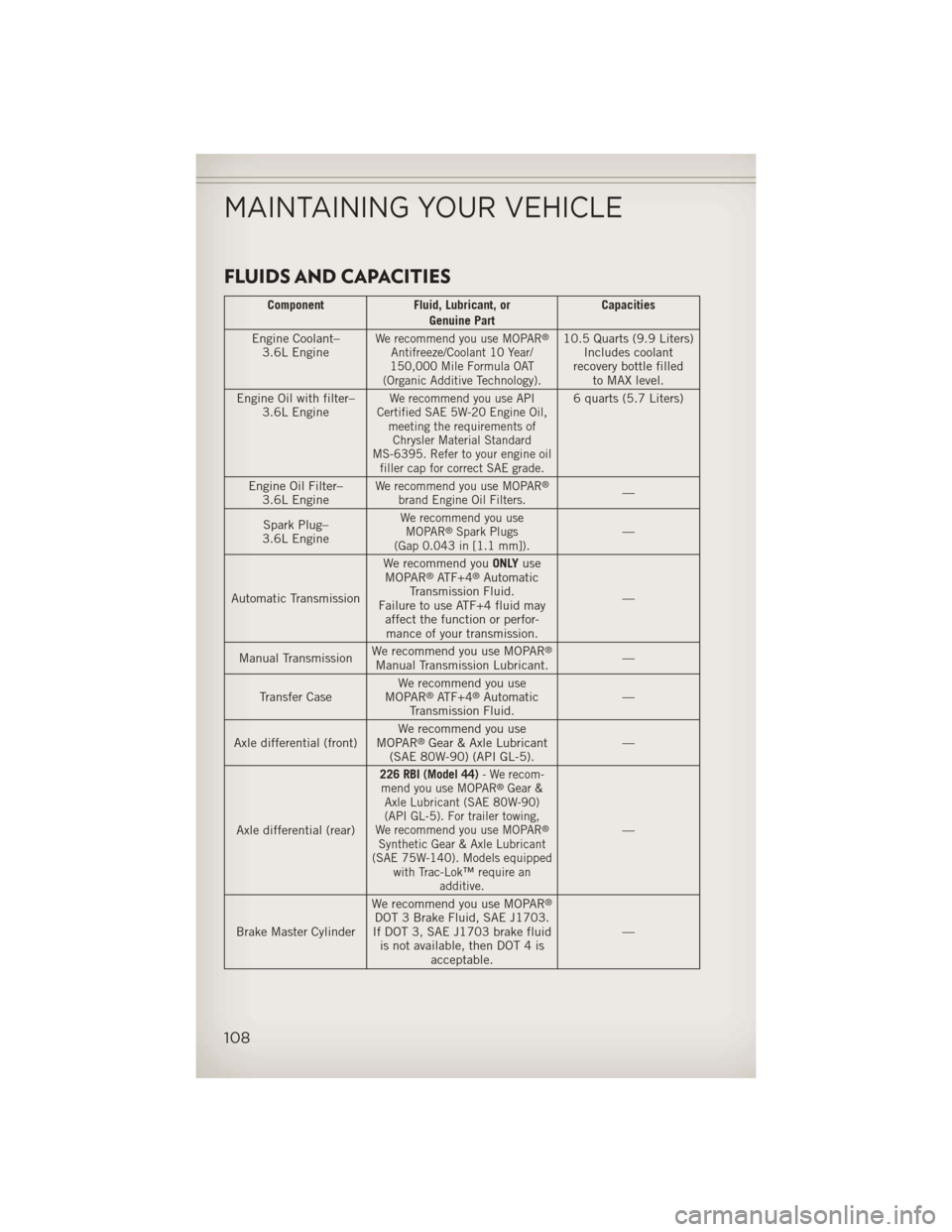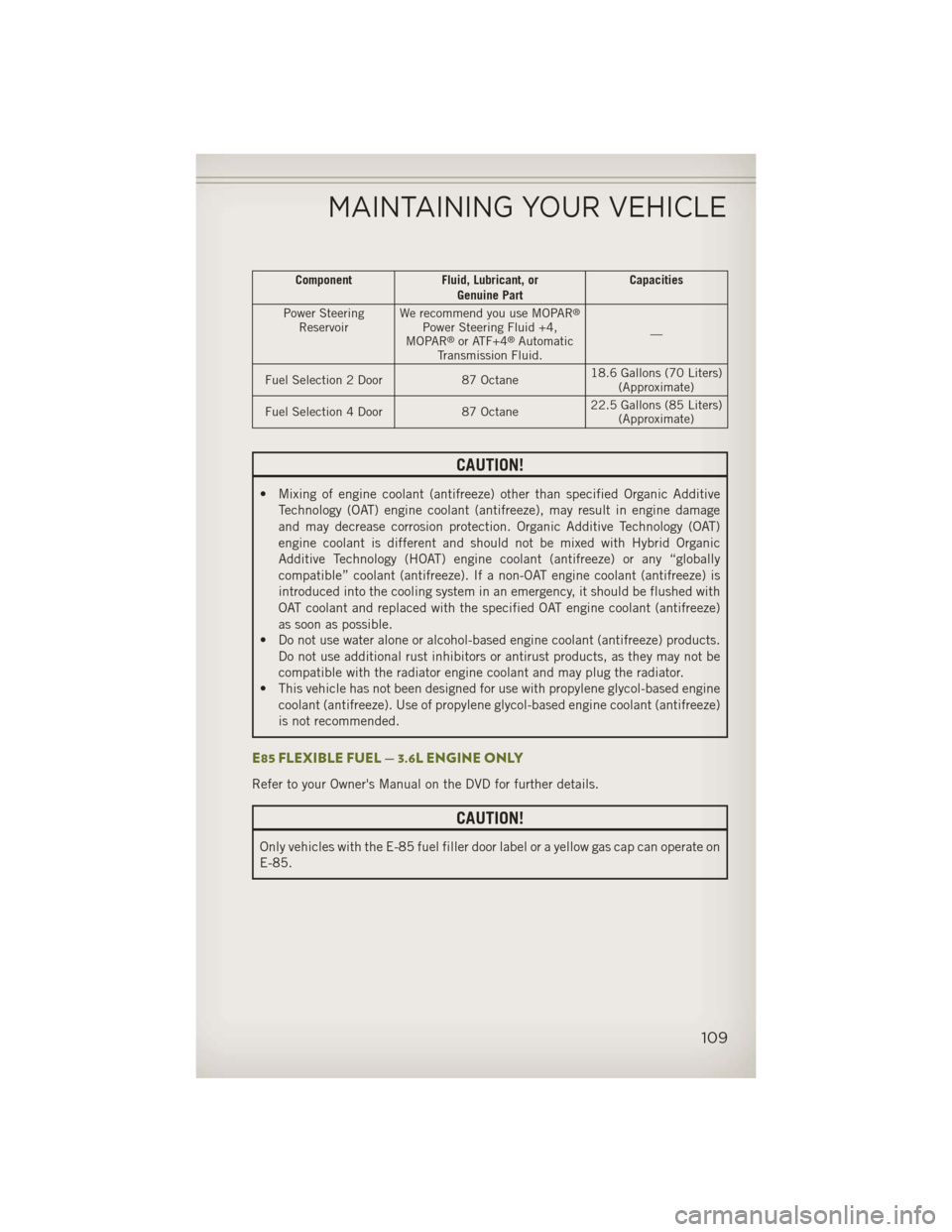Freeze plug JEEP WRANGLER 2013 JK / 3.G User Guide
[x] Cancel search | Manufacturer: JEEP, Model Year: 2013, Model line: WRANGLER, Model: JEEP WRANGLER 2013 JK / 3.GPages: 132, PDF Size: 3.32 MB
Page 104 of 132

Once the engine is started, remove the jumper cables in the reverse sequence:
• Disconnect the negative(-)jumper cable from the engine ground of the vehicle
with the discharged battery.
• Disconnect the negative end (-)of the jumper cable from the negative (-)post of
the booster battery.
• Disconnect the opposite end of the positive (+)jumper cable from the positive (+)
post of the booster battery.
• Disconnect the positive (+)end of the jumper cable from the positive (+)post of
the discharged vehicle.
• If frequent jump-starting is required to start your vehicle you should have the battery and charging system inspected at your authorized dealer.
CAUTION!
• Do not use a portable battery booster pack or any other booster source with a system voltage greater than 12 Volts or damage to the battery, starter motor,
alternator or electrical system may occur.
• Failure to follow these procedures could result in damage to the charging
system of the booster vehicle or the discharged vehicle.
•
Accessories that can be plugged into the vehicle power outlets draw power from
the vehicle’s battery, even when not in use (i.e., cellular phones, etc.). Eventually,
if plugged in long enough, the vehicle’s battery will discharge sufficiently to
degrade battery life and/or prevent the engine from starting.
WARNING!
•When temperatures are below the freezing point, electrolyte in a discharged
battery may freeze. Do not attempt jump-starting because the battery could
rupture or explode and cause personal injury. Battery temperature must be
brought above the freezing point before attempting a jump-start.
•Take care to avoid the radiator cooling fan whenever the hood is raised. It can start
anytime the ignition switch is on. You can be injured by moving fan blades.
• Remove any metal jewelry, such as watch bands or bracelets, that might make
an inadvertent electrical contact. You could be severely injured.
• Batteries contain sulfuric acid that can burn your skin or eyes and generate
hydrogen gas which is flammable and explosive. Keep open flames or sparks
away from the battery.
• Do not allow vehicles to touch each other as this could establish a ground
connection and personal injury could result.
• Failure to follow this procedure could result in personal injury or property
damage due to battery explosion.
• Do not connect the cable to the negative post (-) of the discharged battery.
The resulting electrical spark could cause the battery to explode and could
result in personal injury.
WHAT TO DO IN EMERGENCIES
102
Page 110 of 132

FLUIDS AND CAPACITIES
ComponentFluid, Lubricant, or
Genuine Part Capacities
Engine Coolant– 3.6L Engine
We recommend you use MOPAR®
Antifreeze/Coolant 10 Year/
150,000 Mile Formula OAT
(Organic Additive Technology).10.5 Quarts (9.9 Liters) Includes coolant
recovery bottle filled to MAX level.
Engine Oil with filter– 3.6L Engine
We recommend you use API
Certified SAE 5W-20 Engine Oil, meeting the requirements ofChrysler Material Standard
MS-6395. Refer to your engine oil filler cap for correct SAE grade.6 quarts (5.7 Liters)
Engine Oil Filter– 3.6L Engine
We recommend you use MOPAR®
brand Engine Oil Filters.—
Spark Plug–
3.6L Engine
We recommend you use MOPAR®Spark Plugs
(Gap 0.043 in [1.1 mm]).—
Automatic Transmission We recommend you
ONLYuse
MOPAR
®ATF+4®Automatic
Transmission Fluid.
Failure to use ATF+4 fluid may affect the function or perfor-mance of your transmission. —
Manual Transmission We recommend you use MOPAR
®
Manual Transmission Lubricant. —
Transfer Case We recommend you use
MOPAR
®ATF+4®Automatic
Transmission Fluid. —
Axle differential (front) We recommend you use
MOPAR
®Gear & Axle Lubricant
(SAE 80W-90) (API GL-5). —
Axle differential (rear)
226 RBI (Model 44) - We recom-
mend you use MOPAR®Gear &
Axle Lubricant (SAE 80W-90)
(API GL-5). For trailer towing,
We recommend you use MOPAR
®
Synthetic Gear & Axle Lubricant
(SAE 75W-140). Models equipped with Trac-Lok™ require an additive.—
Brake Master Cylinder We recommend you use MOPAR
®
DOT 3 Brake Fluid, SAE J1703.
If DOT 3, SAE J1703 brake fluid is not available, then DOT 4 is acceptable. —
MAINTAINING YOUR VEHICLE
108
Page 111 of 132

ComponentFluid, Lubricant, or
Genuine Part Capacities
Power Steering Reservoir We recommend you use MOPAR
®
Power Steering Fluid +4,
MOPAR®or ATF+4®Automatic
Transmission Fluid. —
Fuel Selection 2 Door 87 Octane18.6 Gallons (70 Liters)
(Approximate)
Fuel Selection 4 Door 87 Octane22.5 Gallons (85 Liters)
(Approximate)
CAUTION!
• Mixing of engine coolant (antifreeze) other than specified Organic Additive
Technology (OAT) engine coolant (antifreeze), may result in engine damage
and may decrease corrosion protection. Organic Additive Technology (OAT)
engine coolant is different and should not be mixed with Hybrid Organic
Additive Technology (HOAT) engine coolant (antifreeze) or any “globally
compatible” coolant (antifreeze). If a non-OAT engine coolant (antifreeze) is
introduced into the cooling system in an emergency, it should be flushed with
OAT coolant and replaced with the specified OAT engine coolant (antifreeze)
as soon as possible.
• Do not use water alone or alcohol-based engine coolant (antifreeze) products.
Do not use additional rust inhibitors or antirust products, as they may not be
compatible with the radiator engine coolant and may plug the radiator.
• This vehicle has not been designed for use with propylene glycol-based engine
coolant (antifreeze). Use of propylene glycol-based engine coolant (antifreeze)
is not recommended.
E85 FLEXIBLE FUEL — 3.6L ENGINE ONLY
Refer to your Owner's Manual on the DVD for further details.
CAUTION!
Only vehicles with the E-85 fuel filler door label or a yellow gas cap can operate on
E-85.
MAINTAINING YOUR VEHICLE
109